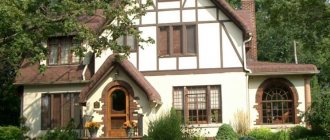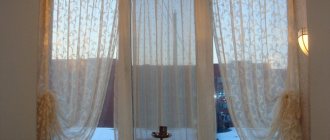Historical wooden windows - throughout their centuries-old history, wooden windows, as an architectural element of buildings, have undergone many design and constructive changes. Various materials and designs replaced each other, fittings and thermal insulation characteristics were gradually improved.
Modern windows in historical design most often represent a partial or complete visual imitation of ancient structures, but at the same time functionally comply with construction standards and comfort requirements of the 21st century.
historical
Window
get a special offer
Manufacturing of wooden windows in historical style
All historic timber windows from OknaBau are custom designed and built to your specifications to perfectly match the style of your home. Our historic windows are created using modern technology and will closely match the historic appearance of your home while offering all the benefits of new technology. According to your requirements, we can produce historical windows of any shape, indistinguishable from the historical original.
Various elements of historical design are actively used to create ancient interiors and characterize facades, for example, in the implementation of Baroque, Rococo, Art Nouveau, Empire, Gothic, Eclectic styles, etc.
- historical figured elements on the frame and sashes (kalevka)
- wooden decorative layouts on double-glazed windows with different shapes of strips and patterns
- historical design window handles
- use of cremonas
- use of capitals
- use of stained glass
- special wooden window with wood from elite species
Windows made in a specific historical architectural style
"GOTHIC"
"BAROQUE"
"ROCOCO"
"CLASSICISM"
Windows should include characteristic historical details
Capitals
The trims on the outside of the window are machined separately and then joined on the window profile in the form of a relief decoration.
Shprosy - Layout
Interglazed bars are easy to use and are a characteristic element of historical windows.
Cremona
Cremona is an antique latch covering the entire height of the window, made with beautiful patterns that were fashionable in the last century.
Historical pens
Exquisite window handles from the best European manufacturers, exquisite retro and time-tested classics.
But, probably, the most important aspect of the use of historical windows is the restoration of architectural monuments and buildings of historical significance, where the first place is to preserve the original appearance of the building, including authentic window structures.
LiveInternetLiveInternet
The history of windows is interesting to consider through the prism of different eras, cultures and religions. If you believe scientific data, the first windows in history (approximately the same windows as we are used to seeing them today) appeared on the Mediterranean island of Crete in the second millennium BC. However, this architectural “novelty” did not receive further development and fell into oblivion along with the decline of the Cretan-Mycenaean civilization. Further, windows became a common architectural element only a few centuries ago, which by the standards of history can be considered an insignificant period. The fact is that ancient houses had no windows. This is by no means due to limited knowledge of architecture or insufficient development of technology. The lack of windows can be explained solely from a practical point of view. The house was a person’s main refuge from heat and cold, from wind, rain and snow, and blank walls coped with these functions in the best possible way, because covering a window opening with glass in those ancient times was simply not possible. In addition, evil spirits could enter homes through window openings - this was believed for a long time.
If we consider the buildings of ancient Greece, Rome and other Mediterranean states of antiquity, we can see the absence of window openings in the modern sense of the word. However, these buildings had another feature - almost everywhere there was a courtyard, which was a full-fledged source of light for the interior. In addition, there were cracks in the walls through which sunlight also penetrated into the rooms. However, if we consider the homes of the ancient Greeks, then such cracks in the walls were not present in all rooms. Basically, they were found only in halls for feasts and other similar rooms, and in rooms intended for women there were no such openings at all. In ancient Egypt, dwellings had another source of lighting - these were special side openings under the roof, covered with bars. These bars are believed to have been designed to protect houses from birds, which in those days was considered a harbinger of troubles and misfortunes. It is worth noting that people still tried to create some kind of illusion of windows - in their homes there were decorative niches painted with paints that imitated the color of the sky and the sun.
Old Russian and Slavic buildings still had some semblance of modern windows. Small holes were made in the walls through which sunlight could penetrate, albeit in negligible quantities. However, due to climatic conditions, there was a need to block such openings from the penetration of wind and cold. An alternative to modern glass was then mica windows (the most “prestigious” and expensive option), bull bladder, even thin plates of wood, burbot skin, paper, as well as fish press and canvas. In winter they could also use regular ice! Oddly enough, such “glass” reliably protected the house from the cold and perfectly let in sunlight. The above imitations of glass could be found in Russian villages about a hundred years ago, both in rural and urban areas. A popular method of protecting a house from the penetration of cold through window openings was also a special sliding board that did not tightly close the window - the so-called fiberglass windows. In order to compensate for even less sunlight, a special design and arrangement of windows in the house were used. As an example, we can cite the oblique windows, which were essentially three windows at once - a large central one and two small side windows located below the central one. Such windows were equipped with frames, jambs and lintel.
From the time of its appearance to the present day, the shapes and sizes of windows have undergone great changes. Studying medieval buildings, we can see small loophole windows and huge French windows that occupied almost the entire wall in the room. The general trend, however, was the constant expansion of window openings, which, to protect from the weather and prying eyes, were closed with wooden shutters. In addition to wooden shutters, metal gratings, carved limestone plates, marble or clay plates were also used - depending on the cultural, weather and craft characteristics of a particular region. For better illumination of interior spaces, from the 17th century, window openings began to be designed in the form of arches, expanding into the interior of the room. Then the windows already had metal frames, which formed a grid of cubes, circles and other geometric shapes on the window. Mica, which replaced modern glass, could be painted in various shades at that time. It is worth noting that mica practically did not provide any thermal insulation, so all windows were required to be equipped with wooden shutters. In some cases, the shutters were additionally upholstered with cloth or fur.
Window openings of large dimensions appeared in European countries during the Renaissance. Thanks to Emperor Peter I, large windows appeared in Russian houses. However, this architectural innovation was perceived with caution, especially by the clergy, which forced the emperor to issue appropriate decrees obliging new buildings to be equipped with large, bright windows (in particular, the decree of 1714, which obligated the use of designs by the architect Trezzini in the construction of houses). The first buildings corresponding to the new trends in St. Petersburg were the Winter and Summer Palaces and the A. Menshikov Palace. In those days, window openings had already begun to be covered with glass, window openings became large, with small glazing, and their very number in houses also increased.
It is worth noting that glass for windows began to be used in the first century AD. It became most widespread at that time in ancient Roman buildings, when the construction of multi-story buildings was mastered. Glass could be used entirely for small windows, or it could be inserted into special window frames made of wood or bronze. Despite this, glass was not widely used as such until the 18th century. Firstly, its production was extremely labor-intensive and expensive. Secondly, the quality of glass in those days left much to be desired: it was thick and cloudy, had a greenish tint and did not transmit sunlight well (it is worth noting that the more traditional mica of that time coped with this task even better). Glass became widespread relatively recently, when the technology of its production had ceased to be a secret and had undergone significant improvements.
Following the wide large windows, Peter I introduced another novelty into Russian architecture - window-doors, which were extremely popular at that time in Western Europe, in particular in France. However, due to the harsh Russian climate, this innovation did not take root and was not widely used.
Classic buildings of the 18th century in Russia were divided into two halves - a rather modest residential area and an area where the luxury and high position of the owners of the house were demonstrated. The central main halls had several rows of large windows, usually located vertically. Living quarters were equipped with windows of much smaller overall dimensions, which could have completely different shapes. Also in the classic interiors of those times you can see another interesting detail - living rooms-verandas, where glass was inserted directly between the columns, replacing full-fledged walls.
In addition to the above-mentioned windows and doors, roof windows, the so-called skylights, also began to be used. However, again due to Russian climatic conditions, most of the time such windows were closed with wooden shutters and caps, which we can see, for example, in the Ostankino Palace. In addition to wooden caps, felt was also used to better insulate roof windows.
It was from the 18th century in Russia that the window as such began to be perceived not only as a source of light, but also as a way to view and admire the surroundings. Therefore, the windows were large, low-set (to view what was happening outside the window even in a sitting position), high and narrow, and ladders and platforms were built opposite the windows - original viewing platforms. Despite the high aesthetic appeal of such structures, they were not suitable for creating comfortable living conditions indoors. And already from the beginning of the 19th century, windows in buildings began to acquire a more practical configuration and overall dimensions.
In the 20th century, the history of windows entered its new stage. With the development of technology, architects have a lot of solutions at their disposal to make a window both practical and aesthetic: all kinds of modifications of windows, various shapes and designs, the use of non-standard materials for the manufacture of frames. By the way, the invention in the mid-50s of the first PVC window profile, which today is already widespread literally everywhere, in a more advanced modification, can be considered a revolutionary stage in the history of modern windows.
Types of windows.
Berlin window. This three-leaf window is usually located in a room located at the intersection of the wings of the building, in the inner corner of the room.
Biforium. A window typical of Romanesque architecture. It is a window of two openings separated by a decorative column.
"Bulls-eye". A window located above the door. As a rule, it has an oval or round shape.
Fan window. The history of this type of window design originates in Romanesque culture. The upper part of this window is a kind of fan of separate interconnected sectors.
Venetian or Palladian window. An arched window consisting of three sectors.
Volokovy window. A narrow long window (up to three meters long). Such windows were located in wooden cobblestone houses and were closed from the inside with special boards.
Red or slanted window. The frame of this window is framed by jambs, often with elegant wooden carvings.
Mezzanine window. These windows are designed to provide better room lighting and are located on top of the main row of window openings.
Second light window. A window located in the interior wall of a building to illuminate dark rooms that do not have window openings facing directly onto the street.
Enveloped window. A window located in the corner of the room.
Rose. A window located above a doorway. Structurally, it is a circle, inside of which there are graceful interlacing rays emanating from the center. Characteristic of Gothic architecture.
Fish bubble. Windows, also characteristic of Gothic architecture. Such windows have a complex curvilinear design.
Blind window. In essence, this is an imitation of a window opening - a special niche in the wall of the room.
Dormer window. A window located in the attic, on the roof slope.
Florentine window. Structurally, such a window consists of several arches, which are united by one arch of a larger radius. https://oknapiter.ru
Series of messages “=history of things=”:
Part 1 - History of things. Fan. Part 2 - Screen in the interior. ... Part 8 - Masterpieces - kerosene lamps. Story. Part 9 - The story of the snowman Part 10 - The story of the window Part 11 - The story of table linen - Tablecloths and napkins Part 12 - DIY snow globe... Part 31 - Cufflinks Part 32 - The ones that are gone forever. History of the inkwell. Part 33 - Fading traditions: from the history of the tear-off wall calendar
Order historical windows - 4 simple steps
You can order the production of historical windows in our office or order a specialist to visit your address by phone.
Consultation with a specialist
By clicking on the application button you can leave your contacts and we will call you back
Taking measurements
Timely arrival at the site of a specialist for measurements and practical advice from the master.
Window production
After you conclude an agreement with us, your order is immediately sent to the production stage
Delivery and installation
You entrust this important task to those who know the intricacies of installing our structures.










